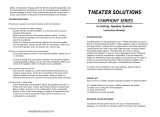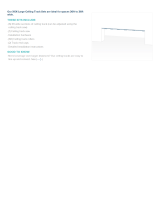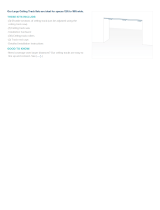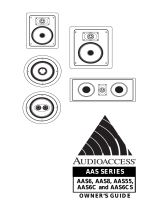Page is loading ...

To obtain the full potential of your new speaker, please read all
instructions before starting the installation.
PARTS LIST
Each Reference Series speaker package includes the following items:
(2) Theater Solutions Reference Series speakers with grilles
(1) Hole cut out and paint mask template
(1) Grille removal tool
(1) Adhesive to secure the grille
SPEAKER LOCATION GUIDE
To achieve the best performance from your Theater Solutions
Speakers, it is important to carefully select the location for installation.
INTRODUCTION
Congratulations on the purchase of your Theater Solutions Reference
Series Speaker System. These speakers were In-Wall manufactured
with high quality components and engineered to accurately reproduce
sound tracks from both music and video sources, including today's
demanding digital signals. Mounted flush to a wall or ceiling,
architectural speaker is ideal for many applications where traditional
speakers would be impractical or impossible.They are especially
suited for distributing sound throughout a house and can be used to
enhance surround sound systems. When properly installed, this
product will provide you with years of entertainment pleasure.
In-Wall Speaker System
Instruction Booklet
TROUBLESHOOTING
Should your speakers not work properly, check the following:
If there is no sound from either speaker:
.Confirm that the receiver/amplifier is on and an active source is
selected and playing.
.Most receivers have an A/B speaker selector switch. Confirm
which output the speakers are connected to (A or B) and make
sure this is selected.
.Check all wiring and connections between the receiver/amplifier
and the speakers. Make sure all wires are connected. Make sure
none of the speaker wires are frayed, cut or punctured.
If the receiver cuts on and off:
.This could be caused by a short circuit between the positive and
negative output leads. Check the connections at the back of the
eceiver/amplifier and then at the speaker. Make sure that no
strands of wire from one connector are touching the other connector.
If there is low or weak bass:
.Check the polarity of the speaker wiring. All speakers must be "in
Phase"with each other or bass performance will be compromised.
.Many modern receivers can be configured to drive a subwoofer
directly. In this mode, bass energy is routed to the subwoofer only.
If you do not have a subwoofer, make sure the receiver is not
configured for a subwoofer.
Onlyfactorydirect 6433 Topanga Cyn. Blvd, Suite 175, Canoga Park,CA 91363
r
THEATER SOLUTIONS
grilles are attached. Always paint the frame and grille separately. Use
the Paint Masking Template to cover the woofer/tweeter assembly to
prevent damage to them. When painting the grille do not put such a
heavy coat of paint on the grille that the perforations are blocked.
If there is no sound coming from one speaker:
.Check the balance control on the receiver/amplifier. Make sure it
is centered.
.Check all wiring and connections between the receiver/amplifier
and the speakers. Make sure all wires are connected. Make sure
none of the speaker wires are frayed, cut or punctured.
REFERENCE SERIES

SPEAKER HOOKUP
The speaker terminals will accommodate any speaker wire up to 12-
gauge. Select an appropriate wire gauge from the following chart.
18ga: up to 25"
16ga: up to 40"
14ga: up to 75"
1
2ga: up to 125"
Split the two conductors of the speaker wire apart about 3 inches so
that they form a "
Y”.? Using wire strippers, remove about 1/2-inch of the
insulation from each wire. When connecting a speaker it is very
important to retain the correct polarity (improper polarity will cause
reduced bass performance and unnatural imaging effects). To do this,
be sure the wire attached to the positive terminal on the speaker
(marked [+] or colored red) connects to the positive terminal on the
receiver. Similarly, the negative terminal (marked [-] or colored black)
must connect to the negative terminal on the receiver.
FINAL INSTALLATION
Using the supplied grille remover, remove the grille from the speaker.
Turn the mounting feet inward so they will clear the cut out hole for
installation. Insert the speaker into the cutout hole and begin to tighten
the installation screws. As you start to turn each screw, the mounting
feet will rotate outward to clamp around the drywall to hold the speaker
securely in place.
CAUTION: DO NOT OVERTIGHTEN THE MOUNTING FEET.
OVERTIGHTENING MAY WARP THE BAFFLE, DAMAGE THE
MOUNTING FEET, OR CRACK THE CEILING, ETC. A SNUG FIT IS ALL
THAT IS NECESSARY TO ASSURE PROPER PERFORMANCE.
PAINTING THE SPEAKERS
The speakers and grilles should be painted before installation. This will
Using the supplied grille adhesive. apply an ample amount of
adhesive around the grille
. Gently push the grille onto the speaker
frame securing the grille.
eliminate ” paint scar”?if the speaker ever needs to be removed. The
speaker frame may also be painted after installation, but before the
Ceiling Installations
Typically, the speakers should be p
laced about 1/3rd of the distance
from the corner of the room to the center of the wall. If possible,
avoid locating the speakers less than two feet away from the corners
of the room.
Wall Installations
As a general rule, the speakers should be mounted close to, or slightly
above the listeners ear level, when seated. The speakers should be
approximately the same distance apart as the distance to the listening
area. If possible, avoid locating the speakers less than two feet away
from the corners of the room.
As Surround Speakers
Surround speakers should be placed slightly behind the listening area
approximately five to six feet above the floor.
SPEAKER INSTALLATION
CAUTION: BE CERTAIN THERE ARE NO ELECTRICAL WIRES, WATER
PIPES, HEATING DUCTS OR ANY OTHER OBSTRUCTIONS IN THE
PLANNED AREA OF INSTALLATION BEFORE YOU START DRILLING
OR CUTTING INTO THE CEILING. IF THERE IS AN ELECTRICAL
OUTLET NEARBY, TURN OFF THE CIRCUIT BREAKER TO AVOID
POSSIBLE INJURY.
Th
ese in-wall speakers is designed to be mounted between the
studs. Use a stud finder to locate the positions of joints and rafters.
Make sure you have a 2 " clearance from the outside of the cutout hole
from joints and rafters.
Drill a 1/ pilot hole in the center of the area you plan to mount the4"
speaker. Cut or bend a piece of wire (a coat hanger works well) to a
90 degree angle. Insert the wire into the pilot hole and fish around to
make sure that no pipes, studs or other objects will interfere with the
installation. If you must choose another location the pilot hole can be
easily patched.
Once you have a suitable location, use masking tape to temporarily
place the supplied cutout template on the ceiling, centered over the
pilot hole. Draw a circle around the inside edge of the template. Use a
drywall saw or keyhole saw to remove the material inside the circle
inscribed by the template. Confirm that the speaker easily fits in the
hole, without any gaps.
/



